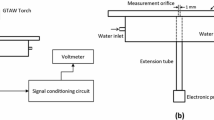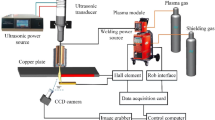Abstract
Due to the strong requirement of keyhole TIG (K-TIG) welding for arc length stability and the advantages of voltage sensing, it is necessary to discuss the relationship between the voltage and arc length. In this paper, based on several groups of experiments, a nonlinear transition point between the relationship of voltage and arc length was found with increasing arc length. Then, to analyze the formation mechanism of the nonlinear transition, a simplified arc physical model was developed. After considering the variations in the welding parameter, the reduction in arc pressure was found to be the main factor leading to a nonlinear relationship, while the shielding gas flow rate is the most effective parameter. This work lays a foundation for better understanding the welding arc and real-time control of arc length by voltage sensing in K-TIG welding.













Similar content being viewed by others
Availability of data and material
The authors confirm that the data supporting the findings of this study are available within the article. The raw data are available from the corresponding author upon request.
References
Cui Y, Shi Y, Zhu T, Cui S (2020) Welding penetration recognition based on arc sound and electrical signals in K-TIG welding. Measurement : J Manuf Process 163:107966. https://doi.org/10.1016/j.measurement.2020.107966
Shi Y, Cui S, Zhu T, Gu S, Shen X (2018) Microstructure and intergranular corrosion behavior of HAZ in DP-TIG welded DSS joints. J Mater Process Tech 256:254–261. https://doi.org/10.1016/j.jmatprotec.2018.02.019
Jarvis BL (2001) Keyhole gas tungsten arc welding: a new process variant
Lathabai S, Jarvis BL, Barton KJ (2001) Comparison of keyhole and conventional gas tungsten arc welds in commercially pure titanium. Mater Sci Eng, A 299:81–93. https://doi.org/10.1016/S0921-5093(00)01408-8
Lathabai S, Jarvis BL, Barton KJ (2008) Keyhole gas tungsten arc welding of commercially pure zirconium. Sci Technol Weld Joi 13:573–581. https://doi.org/10.1179/136217108X329296
Feng Y, Luo Z, Liu Z, Li Y, Luo Y, Huang Y (2015) Keyhole gas tungsten arc welding of AISI 316L stainless steel. Mater Design 85:24–31. https://doi.org/10.1016/j.matdes.2015.07.011
Fei Z, Pan Z, Cuiuri D, Li H, Wu B, Su L (2019) Improving the weld microstructure and material properties of K-TIG welded armour steel joint using filler material. Int J Adv Manuf 100:1931–1944. https://doi.org/10.1007/s00170-018-2787-y
Cui S, Liu Z, Fang Y, Luo Z, Manladan SM, Yi S (2017) Keyhole process in K-TIG welding on 4 mm thick 304 stainless steel. J Mater Process Tech 243:217–228. https://doi.org/10.1016/j.jmatprotec.2016.12.027
Cui S, Shi Y, Zhu T, Liu W (2019) Microstructure, texture, and mechanical properties of Ti-6Al-4V joints by K-TIG welding. J Manuf Process 37:418–424. https://doi.org/10.1016/j.jmapro.2018.12.022
Liu Z, Fang Y, Cui S, Yi S, Qiu J, Jiang Q, Liu W, Luo Z (2017) Keyhole thermal behavior in GTAW welding process. Int J Therm Sci 114:352–362. https://doi.org/10.1016/j.ijthermalsci.2017.01.005
Liu Z, Chen S, Liu S, Luo Z, Yuan J (2018) Keyhole dynamic thermal behaviour in K-TIG welding process. Int J Heat Mass Tran 123:54–66. https://doi.org/10.1016/j.ijheatmasstransfer.2018.02.064
Li H (2011) Numerical analysis on keyhole gas tungsten arc welding. Lanzhou University of Technology
Zhu T, Shi Y, Cui S, Cui Y (2019) Recognition of weld penetration during K-TIG Welding based on acoustic and visual sensing. Sensing and Imaging 20:1–21. https://doi.org/10.1007/s11220-018-0224-9
Xu Y, Fang G, Chen S, Zou JJ, Ye Z (2014) Real-time image processing for vision-based weld seam tracking in robotic GMAW. Int J Adv Manuf Tech 73:1413–1425. https://doi.org/10.1007/s00170-014-5925-1
Guo B, Shi Y, Yu G, Liang B, Wang K (2016) Weld deviation detection based on wide dynamic range vision sensor in MAG welding process. Int J Adv Manuf Tech 87:3397–3410. https://doi.org/10.1007/s00170-016-8721-2
Cui Y, Shi Y, Ning Q, Chen Y, Zhang B (2021) Investigation into keyhole-weld pool dynamic behaviors based on HDR vision sensing of real-time K-TIG welding process through a steel/glass sandwich. Adv Manuf 9:136–144. https://doi.org/10.1007/S40436-020-00335-W
Pan J (2003) Arc welding control. Elsevier
Liao B, Wu S, Pan J (1996) Theoretical Model and Signal Processing of Arc sensor [J]. Transactions of the China Welding Institution 4
Shi YH, Yoo WS, Na S (2006) Mathematical modelling of rotational arc sensor in GMAW and its applications to seam tracking and endpoint detection. Sci Technol Weld Joi 11:723–730. https://doi.org/10.1179/174329306X153196
Shi Y, Kim J, Na S (2005) Signal patterns of high speed rotational arc sensor for gas metal arc welding. Sensors for Industry Conference, 2005 [C]. IEEE. https://doi.org/10.1109/SICON.2005.257861
Cui Y, Shi Y, Hong X (2019) Analysis of the frequency features of arc voltage and its application to the recognition of welding penetration in K-TIG welding. J Manuf Process 46:225–233. https://doi.org/10.1016/j.jmapro.2019.09.002
Hsu KC, Pfender E (1983) Two-temperature modeling of the free-burning, high-intensity arc. J Appl Phys 54:4359–4366. https://doi.org/10.1063/1.332672
Gonzalez JJ, Gleizes A, Proulx P, Boulos M (1993) Mathematical modeling of a free-burning arc in the presence of metal vapor. J Appl Phys 74:3065–3070. https://doi.org/10.1063/1.354624
Cohen RS, Spitzer L Jr, Routly PM (1950) The electrical conductivity of an ionized gas. Phys Rev 80:230. https://doi.org/10.1103/PhysRev.80.230
Jackson CE (1960) The science of arc welding. Welding J 39:129s–140s
Zhang R, Li H, Li M, Wang R, Leng X (2012) Numerical analysis on keyhole gas tungsten arc welding. Electric Welding Machine 42:7–11
Tanaka M, Yamamoto K, Tashiro S, Nakata K, Yamamoto E, Yamazaki K, Suzuki K, Murphy AB, Lowke JJ (2010) Time-dependent calculations of molten pool formation and thermal plasma with metal vapour in gas tungsten arc welding. J Phys D Appl Phys 43:434009. https://doi.org/10.1088/0022-3727/43/43/434009
Yamamoto K, Tanaka M, Tashiro S, Nakata K, Yamazaki K, Yamamoto E, Suzuki K, Murphy AB (2008) Numerical simulation of metal vapor behavior in arc plasma. Surf Coat Tech 202:5302–5305. https://doi.org/10.1016/j.surfcoat.2008.06.079
Park H, Trautmann M, Tanaka K, Tanaka M, Murphy AB (2017) Mixing of multiple metal vapours into an arc plasma in gas tungsten arc welding of stainless steel. J Phys D Appl Phys 50:43L. https://doi.org/10.1088/1361-6463/aa8b06
Converti J (1981) Plasma-jets in arc welding. Massachusetts Institute of Technology
Lancaster JF (1984) The physics of welding. Phys Technol 15:73
Wang J, Lei Y, Zhu B (2008) Numerical analysis on flow field of plasma arc. Welding And Joining Harbin 2:27
Chen L (2017) Study on minimum quantity of shielding gas in GMAW. Jiangsu University
Acknowledgements
The authors gratefully acknowledge the financial support for this work from the Key Research and Development Program of Guangdong Province (Grant No. 2020B090928003), National Natural Science Foundation of Guangdong Province (Grant No. 2020A1515011050), and the Guangdong Province Marine Economic Development Project (Grant No. GDOE[2019]A13).
Funding
The research leading to these results received funding from the Key Research and Development Program of Guangdong Province (Grant No. 2020B090928003), National Natural Science Foundation of Guangdong Province (Grant No. 2020A1515011050), and the Guangdong Province Marine Economic Development Project (Grant No. GDOE[2019]A13).
Author information
Authors and Affiliations
Corresponding author
Ethics declarations
Ethics approval
Not applicable.
Consent to participate
Not applicable.
Consent for publication
Not applicable.
Conflict of interest
The authors declare no competing interests.
Additional information
Publisher's Note
Springer Nature remains neutral with regard to jurisdictional claims in published maps and institutional affiliations.
Rights and permissions
About this article
Cite this article
Wang, J., Shi, Y., Cui, Y. et al. Investigation of the relationship between voltage and arc length of K-TIG welding under penetrated condition. Int J Adv Manuf Technol 120, 3843–3857 (2022). https://doi.org/10.1007/s00170-022-09008-3
Received:
Accepted:
Published:
Issue Date:
DOI: https://doi.org/10.1007/s00170-022-09008-3




